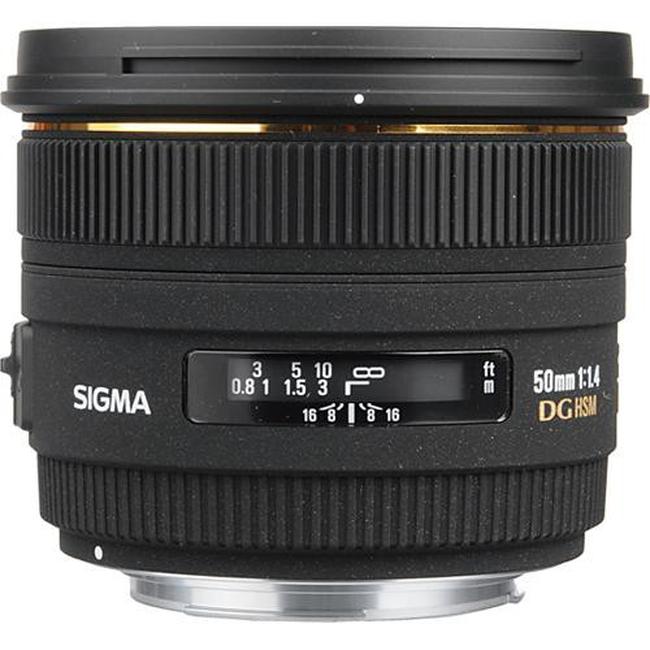LENS INDEX RESULT
Lens 1: Sigma 50mm f/1.4 EX DG HSM Canon EF
REVIEW| Model Name: Sigma 50mm f/1.4 EX DG HSM Canon EF specifications. | |
|---|---|
| Image: |  |
| Fivercam Price (used) UK | |
| eBay Price (used) UK | |
| Support Website | Link |
| Release Date | Mar 18, 2008 |
| General Specifications | |
Lens type  | Prime lens |
Max Format Size  | 35mm FF |
Focal length  | 50 mm |
Image Stabilization  | No |
CIPA Image Stabilization Rating  | |
Lens mount  | Canon EF, Four Thirds, Nikon F (FX), Pentax KAF3, Sigma SA Bayonet, Sony/Minolta Alpha |
| Aperture Details | |
Maximum Aperture  | F1.4 |
Minimum Aperture  | F16 |
Aperture Ring  | No |
Number Of Diaphragm blades  | 9 |
| Aperture Notes | rounded blades |
| Optics (Optical Elements) | |
Elements  | 8 |
Groups  | 6 |
Special Elements  | 1 Aspherical element |
Coatings  | |
| Focus Specs | |
Minimum Focus  | 0.45 m (17.72″) |
Maximum Magnification  | 0.14× |
| Motor Type | Ring-type ultrasonic |
Fulltime Manual  | Yes |
Focus Method  | Unit |
| Focus Notes | internal to lens barrel |
Distance Scale  | Yes |
Depth-of-Field Scales (DoF) Scale  | Yes |
Focus Distance Limiter  | |
| Physical Specs | |
| Weight | 505 g (1.11 lb) |
| Diameter | 85 mm (3.33″) |
| Length | 68 mm (2.69″) |
| Materials | Plastic barrel, metal mount |
| Sealing | |
| Colour | Black |
Zoom Method  | |
Power Zoom  | |
| Zoom Lock | |
| Filter Thread | 77 mm |
| Filter Notes | Does not rotate on focus |
| Hood Supplied | Yes |
| Hood Product Code | |
Tripod Collar  | No |
| Notes | Nikon, Pentax, Sigma, Sony & Four Thirds mounts |
| Optional Accessories | |
| Lens Comparison Websites | |
| CameraDecision Website | Link |
| DPReview Website | Link |
| Introduction: The Sigma 50mm f/1.4 EX DG HSM Canon EF is a Prime lens lens that was released on Mar 18, 2008. In this review, we will explore the various features and specifications to help you make an informed decision about whether this is the right lens for you. | |
| Body and Design: The Sigma 50mm f/1.4 EX DG HSM Canon EF not only delivers exceptional optical performance but also excels in terms of portability. Weighing in at 505 g (1.11 lb) and with a diameter of 85 mm (3.33″) and a length of 68 mm (2.69″), make it a reliable and convenient choice for photographers who value both the quality of their images and the ease with which they can carry and use their equipment. | |
| Specifications: This lens offers a maximum format size of 35mm FF, providing expansive coverage for stunning photography with a focal length of 50 mm. This lens provides a maximum aperture of F1.4, delivering versatility for different lighting conditions. With a minimum aperture of F16, it allows for precise control over depth of field and exposure settings. Featuring 9 diaphragm blades, the lens is designed to produce smooth and attractive bokeh, enhancing the aesthetic quality of out-of-focus elements in your images. The Sigma 50mm f/1.4 EX DG HSM Canon EF is constructed with a sophisticated optical design, featuring 8 elements arranged in 6 groups. This design ensures top-tier imaging performance, providing clarity, sharpness, and minimal aberrations across diverse shooting scenarios. The meticulous arrangement of optical elements contributes to the overall excellence, enabling photographers to capture detailed and pristine images. With a minimum focus distance of 0.45 m (17.72″), the Sigma 50mm f/1.4 EX DG HSM Canon EF allows photographers to get relatively close to their subjects, capturing intricate details with precision. The lens offers a maximum magnification of 0.14×. | |
| Conclusion: The Sigma 50mm f/1.4 EX DG HSM Canon EF excels optically. Weighing 505 g (1.11 lb) with 85 mm (3.33″) diameter and 68 mm (2.69″) lenght, it adapts to diverse scenes with a max format size of 35mm FF and 50 mm focal length. With a F1.4 aperture and 9 diaphragm blades, it ensures quality shots. This review helps you decide if it suits your needs. | |
| Item 1 | |
Fivercam Wiki information:
What type of lenses are there? DSLR and Mirrorless cameras have either full-frame or crop sensors. While full-frame lenses can be used on a crop sensor, a lens designed for a crop sensor cannot be used on a full frame. Camera lenses can be broken down into two main types, zoom lenses and prime lenses. Zoom lenses are one of the most common types of lenses that you will need. While Prime lenses have a fixed focal range, which means that you cannot zoom in or out. They are perfect for portraits or landscape photography. The other lens types are fisheye for abstract photography, wide angle for landscape and architecture, standard lenses and short telephoto lenses for street, travel and portrait, medium telephoto for sports, wildlife, action, super telephoto for sports from a distance, nature and astronomy and macro for close-up shots.
Spotted a mistake? Please contact office@fivercam.com!